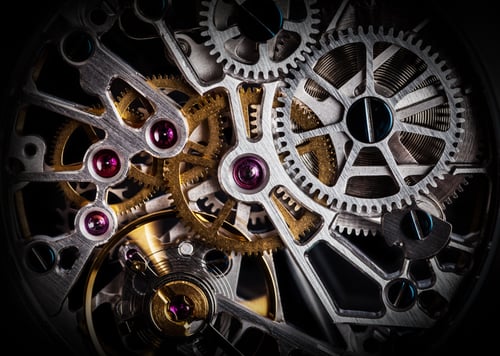When you encounter the phrase "jewels in watches," you might envision the custom-made watches adorned with rubies, sapphires, or even diamonds. However, within the realm of watchmaking, "jewels" refer not to the external embellishments but to the intricate components nestled inside the timepiece.
Initially introduced to mitigate friction and prolong the lifespan of watches, these precious stones have evolved into somewhat of a fascination among enthusiasts.
Here, we delve into the inner mechanisms of your timepiece, exploring the role of jewels in watches.
Watches are remarkable feats of intricate engineering, comprising hundreds of meticulously crafted components tailored to fit snugly within the compact confines of a wristwatch. Some timepieces boast an astonishing array of up to 2800 individual parts!
When you peer beneath the face of an average watch, you're met with a mesmerizing display of moving parts. From the ratchet wheel to the barrel bridge, the balance to the lever pilot, each element plays a crucial role in the watch's functionality. Among these components, you may also encounter jewels, known as jewel bearings.
The incorporation of jewel bearings into watch movements, the inner mechanisms that drive the watch, emerged as a solution to the challenge of excessive friction. With all the moving parts within watch movements crafted from metal, the potential for friction-induced wear is significant.
By introducing precious stones into the equation, watchmakers sought to mitigate this friction and alleviate the tension that arises from metal-on-metal contact. These stones, renowned for their durability, can withstand the demanding conditions of constant motion within a watch mechanism. Serving as pivots between gears, jewels effectively supplant traditional bearings, ensuring smoother operation and prolonged durability of the timepiece.

The standard count of jewels found in watches typically stands at 17 for fully mechanical models. However, self-winding automatic and semi-automatic watches may boast even more, ranging from 25 to 27.
Yet, the presence of additional jewels in a watch doesn't necessarily equate to higher value. Nowadays, these precious stones, utilized as bearings within watches, often consist of imitation materials.
Synthetic jewels, cultivated in controlled environments, offer enhanced precision and manufacturing control. Watchmakers can ensure optimal toughness. Often resembling rubies, they undergo buffing, cutting, milling, and polishing to attain the required brick, donut, or half-tube shape. The manufacturing process itself is imbued with luxury, often employing diamond-tipped tools for precise control.
Hole Jewels: A pierced jewel, also referred to as a hole jewel, features a bored hole enabling it to be mounted on a wheel's axle or pivots like cylindrical or conical ones, typically with a slightly rounded top or flat bottom. When paired with a cap jewel, they form a pivot bearing set, facilitating axle rotation, and when applied to the balance staff, they constitute an anti-shock mechanism with springs for absorbing shocks.
Cap Jewels: A cap jewel, lacking a bored hole, serves to reduce movement in the balance staff, often paired with a pivot jewel and equipped with shock protection, typically consisting of springs at each end, safeguarding the watch from impacts if dropped or struck while worn.
Pallet Jewels: A pallet jewel, typically made of hard materials such as synthetic ruby or sapphire, is a small, precisely shaped component found on the pallet fork within a watch's escapement mechanism. It works by interacting with the escape wheel teeth to control the release of energy to the balance wheel, which is essential for accurate timekeeping and reliability in the watch's movement.
Roller Jewels: A roller jewel, situated within the pallet fork, serves as the pivotal connection between the escape wheel and the pallets in a watch's escapement mechanism.
Jewels: Rubies, serving as bearings for pivots, are integrated into watch movements to diminish friction. Generally, a high-quality mechanical watch movement will incorporate between 15 and 21 jewels, although the count can exceed this significantly.
Most jewelled watches typically incorporate around 17 jewels distributed across various components:
Balance Wheel: One impulse jewel positioned where the escapement lever strikes it.
Staff Pivot: Two sets of jewels (a hole jewel and a cap jewel, each occurring twice) function as pivot bearings on the staff pivot.
Centre Wheel: A pair of jewels (a hole jewel and a cap jewel) serve as a pivot bearing for the centre wheel.
Escape Lever Pallet: Two pallet jewels are utilized in the escape lever pallet.
Escape Lever: A pair of jewels (a hole jewel and a cap jewel) act as pivot bearings in the escape lever.
Fourth Wheel: A pair of jewels (a hole jewel and a cap jewel) function as pivot bearings in the 4th wheel.
Third Wheel: A pair of jewels (a hole jewel and a cap jewel) serve as pivot bearings in the 3rd wheel.
Escape Wheel: A pair of jewels (a hole jewel and a cap jewel) are used as pivot bearings in the escape wheel.
A timepiece labelled as having 17 jewels is commonly referred to as a fully jewelled watch. This indicates that it employs jewel bearings, typically made of ruby, throughout the mechanical movement, extending from the balance wheel to the centre wheel pivot.
Comparable to a 17-jewel watch featuring a fully jewelled movement, some timepieces incorporate additional capstones to minimize positional errors. These supplementary stones are frequently present in higher-quality watches.
If you’re looking to add a luxury watch to your collection, now is a great time to pick up a pre-owned model. Here at BQ Watches, we have a carefully curated selection of watches for you to browse.
If you can’t find what you’re looking for in our online inventory, make sure to get in touch with our expert team. We’re happy to source a luxury watch for you and help you find your ideal timepiece. Fill out our contact form below and a member of our team will reach out right away to assist you.